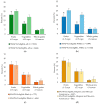Poor Dietary Guidelines Compliance among Low-Income Women Eligible for Supplemental Nutrition Assistance Program-Education (SNAP-Ed)
- PMID: 29518042
- PMCID: PMC5872745
- DOI: 10.3390/nu10030327
Poor Dietary Guidelines Compliance among Low-Income Women Eligible for Supplemental Nutrition Assistance Program-Education (SNAP-Ed)
Abstract
The Supplemental Nutrition Assistance Program-Education (SNAP-Ed) program aims to improve nutritional intakes of low-income individuals (<185% poverty threshold). The objective of this study was to describe the compliance with Dietary Guidelines for Americans (DGA) recommendations for fruits, vegetables, and whole grains among SNAP-Ed eligible (n = 3142) and ineligible (n = 3168) adult women (19-70 years) nationwide and SNAP-Ed participating women in Indiana (n = 2623), using the NHANES 2007-2012 and Indiana SNAP-Ed survey data, respectively. Sensitivity analysis further stratified women by race/ethnicity and by current SNAP participation (<130% poverty threshold). Nationally, lower-income women were less likely to meet the fruit (21% vs. 25%) and vegetable (11% vs. 19%) guidelines than higher-income women, but did not differ on whole grains, which were ~5% regardless of income. The income differences in fruit and vegetable intakes were driven by non-Hispanic whites. Fewer SNAP-Ed-eligible U.S. women met fruit (21% vs. 55%) and whole grain (4% vs. 18%) but did not differ for vegetable recommendations (11% vs. 9%) when compared to Indiana SNAP-Ed women. This same trend was observed among current SNAP participants. Different racial/ethnic group relationships with DGA compliance were found in Indiana compared to the nation. Nevertheless, most low-income women in the U.S. are at risk of not meeting DGA recommendations for fruits (79%), vegetables (89%), and whole grains (96%); SNAP-Ed participants in Indiana had higher compliance with DGA recommendations. Increased consumption of these three critical food groups would improve nutrient density, likely reduce calorie consumption by replacing high calorie choices, and improve fiber intakes.
Keywords: Dietary Guidelines; NHANES; SNAP; SNAP-Education; diet disparities; fruit; low-income; nutrition; vegetable; whole grain.
Conflict of interest statement
The authors declare no conflict of interest. The funding sponsors had no role in the design of the study; in the collection, analyses, or interpretation of data; in the writing of the manuscript, and in the decision to publish the results.
Figures

Similar articles
-
Diet Quality and Associations with Food Security among Women Eligible for Indiana Supplemental Nutrition Assistance Program-Education.J Nutr. 2020 Aug 1;150(8):2191-2198. doi: 10.1093/jn/nxaa171. J Nutr. 2020. PMID: 32559278 Free PMC article.
-
Trends and Disparities in Diet Quality Among US Adults by Supplemental Nutrition Assistance Program Participation Status.JAMA Netw Open. 2018 Jun;1(2):e180237. doi: 10.1001/jamanetworkopen.2018.0237. JAMA Netw Open. 2018. PMID: 30498812 Free PMC article.
-
Supplemental Nutrition Assistance Program participation did not help low income Hispanic women in Texas meet the dietary guidelines.Prev Med. 2014 May;62:44-8. doi: 10.1016/j.ypmed.2014.01.016. Epub 2014 Feb 12. Prev Med. 2014. PMID: 24530319
-
Farmers' market shopping and dietary behaviours among Supplemental Nutrition Assistance Program participants.Public Health Nutr. 2015 Sep;18(13):2407-14. doi: 10.1017/S1368980015001111. Epub 2015 Apr 21. Public Health Nutr. 2015. PMID: 25895894 Free PMC article. Review.
-
Aligning nutrition assistance programs with the Dietary Guidelines for Americans.Nutr Rev. 2013 Sep;71(9):622-30. doi: 10.1111/nure.12046. Epub 2013 Aug 15. Nutr Rev. 2013. PMID: 24032366 Review.
Cited by
-
Mediation by self-efficacy in the relation between social support and dietary intake in low-income postpartum women who were overweight or obese.Appetite. 2019 Sep 1;140:248-254. doi: 10.1016/j.appet.2019.05.031. Epub 2019 May 26. Appetite. 2019. PMID: 31141706 Free PMC article.
-
Diet Quality and Associations with Food Security among Women Eligible for Indiana Supplemental Nutrition Assistance Program-Education.J Nutr. 2020 Aug 1;150(8):2191-2198. doi: 10.1093/jn/nxaa171. J Nutr. 2020. PMID: 32559278 Free PMC article.
-
Whole Grain and Refined Grains: An Examination of US Household Grocery Store Purchases.J Nutr. 2022 Feb 8;152(2):550-558. doi: 10.1093/jn/nxab382. J Nutr. 2022. PMID: 34718663 Free PMC article.
-
Adherence to Food-Based Dietary Guidelines: A Systemic Review of High-Income and Low- and Middle-Income Countries.Nutrients. 2021 Mar 23;13(3):1038. doi: 10.3390/nu13031038. Nutrients. 2021. PMID: 33807053 Free PMC article.
-
Feasibility, Acceptability, and Initial Efficacy of a Digital Intervention to Improve Consumption of Foods Received within a National Nutrition Assistance Program.Nutrients. 2023 Jan 14;15(2):438. doi: 10.3390/nu15020438. Nutrients. 2023. PMID: 36678309 Free PMC article.
References
-
- U.S. Department of Agriculture Food and Nutrition Service. Supplemental Nutrition Assistance Program Education Plan Guidance FY 2018. [(accessed on 20 November 2017)]; Available online: https://snaped.fns.usda.gov/snap/Guidance/FY2018SNAP-EdPlanGuidance.pdf.
-
- Williams P.A., Cates S.C., Blitstein J.L., Hersey J.C., Kosa K.M., Long V.A., Singh A., Berman D. Evaluating the Impact of Six Supplemental Nutrition Assistance Program Education Interventions on Children’s At-Home Diets. Health Educ. Behav. 2015;42:329–338. doi: 10.1177/1090198114558589. - DOI - PubMed
-
- U.S. Department of Agriculture Dietary Guidelines for Americans 2015–2020. [(accessed on 20 November 2017)]; Available online: https://health.gov/dietaryguidelines/2015/resources/2015-2020_Dietary_Gu....
MeSH terms
Substances
LinkOut - more resources
Full Text Sources
Other Literature Sources
Medical
Miscellaneous

